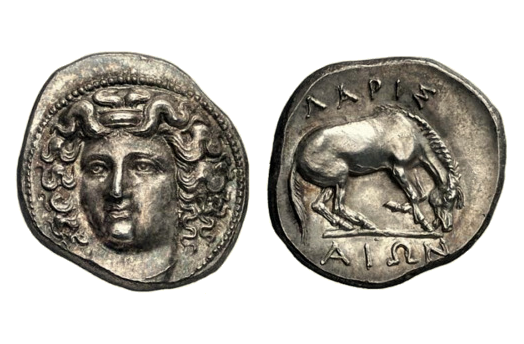
about ancient nomos
Ancient Nomos Art is a museum of galleries exhibiting ancient coins and ancient mint maps. The coin gallery displays the diverse art and history of hand-crafted ancient Greek, Roman, Byzantine, Persian and Medieval coinage. The ancient mints mapping gallery features Greek, Roman, Byzantine, Asia Minor and Medieval mint city regions and territories. Visitor's are welcome to explore, study and enjoy Ancient Nomos Art.

Greek, Thessaly – 360 BC
Larissa
From Ancient Galleries

Obverse: Diademed head of nymph Larissa facing slightly left, wearing ampyx.
Reverse: Horse grazing to right with one leg raised and preparing to roll over.
LEGEND SYMBOLS
Obv: Diademed head of the nymph Larissa facing slightly left, wearing drop earring and necklace with her hair in flowing locks loose at the sides, bound with an ampyx. Rev: ΛΑΡΙΣ above, ΑΙΩΝ below with female horse grazing to right and perhaps preparing to roll over.
The ancient city of Larissa was the leading city of Thessaly and is located inland from the Aegean along the Pineios River. The region surrounding Larissa is perhaps the most fertile agricultural land in Greece. The vast Thessaly pasture lands were well known during antiquity for the breeding of fine horses. The ancient historians believe Larissa was founded by Acrisios, father of Danae, and accidentally killed by Persus, and so named after the eponymous fountain nymph Larissa, prophetess of Apollo (Pausanius 2.24.1). The great wealth and ancient prosperity of Larissa allow her to be the most prolific mint in the region. From the early 5th century to the end of the 4th century, Larissa produced a long series of coins whose two principal obverse themes. The first centered on Bull wrestling (see Thessaly 435 BC), and the second, a full-facing portrait of Larissa. This 4th century drachm features the later full-facing Larissa. It is artistic style and portrait inspired by the Syracuse engraver Kimon, whose contemporary coins depict the exquisite full-face nymph Arethusa. Here we have Larissa seen facing slightly to the left with her hair in beautiful flowing locks, loose at the sides, and bound ever so slightly with her ampyx headband. She is also seen wearing a sphendone scarf and hint of a necklace. This new design was also accompanied by a new reverse conception of Thessaly’s famous horses. The previous galloping horse reverse was revised to depict a single horse alone in pasture. Several reverse dies studies suggest the horse is a mare and is some cases a pregnant mare. An allusion perhaps to Larissa in animal form (unborn foal?), and symbolic of a courtship with the god of horses, Poseidon, adopting his alter form as male steed.
DOCUMENTATION
Value: Drachm. Metal: AR Silver. Weight: 6.09 grams. Mint: Thessaly, Larissa. Date: 360-330 BC.
Attribution: Lorber, Hoard phase L-III, 38-63; Herrmann Group VII, Series A (1924), pl. V, 5; BMC Thessaly pg. 29, 57; SNG Copenhagen 121; Bâle 17-1988, 175.
Legend, Documentation and Attribution
